There are coffee drinkers and coffee lovers.
Voltaire fell into the latter category, guzzling up to 70 cups per day (and living into his 80s).
Beethoven hand-counted precisely 60 beans per cup. Once he perfected the formula, he never strayed.
Voltaire and Beethoven are on the Mt. Rushmore of coffee lovers, but there may also be a place for you. You may already home-roast the best raw beans and even hand-count them like Beethoven, but have you considered DIYing the process from start to finish? Even if you live in Cincinnati?
Growing coffee plants indoors is entirely possible and surprisingly rewarding. This guide will walk you through the steps.

60 beans per cup — Beethoven discovered the perfect formula for coffee.
The Origins of the Coffee Plant
The coffee plant (genus Coffea) originated in the lush highlands of Ethiopia. Legend credits a goat herder with the discovery when his billies, kids, and nannies nibbled ripe coffee cherries and experienced an unusual surge of energy. The first recorded coffee buzz was in a goat.
Since then, coffee has grown into a global phenomenon. Over 2.25 billion cups of coffee are consumed daily, making it one of the world’s most sought-after beverages.
Coffee is an evergreen shrub or small tree that grows naturally in tropical regions. Arabica and Robusta are the two most popular coffee species, each with unique growing requirements and coffee profiles. Arabica beans are sweeter and more nuanced, while Robusta beans are bold and more caffeinated.
Best Coffee Varieties for Indoor Cultivation
Arabica is the go-to choice for most indoor growers due to its smaller size and easier care.
- Arabica Bourbon has a sweet flavor and compact size.
- Arabica Typica has a taller growth habit but is still manageable indoors.
- Arabica Dwarf is perfect for small spaces and beginner gardeners.
Avoid Robusta unless you have the time and space to care for a much larger, less forgiving plant and enjoy a stronger, more bitter taste.
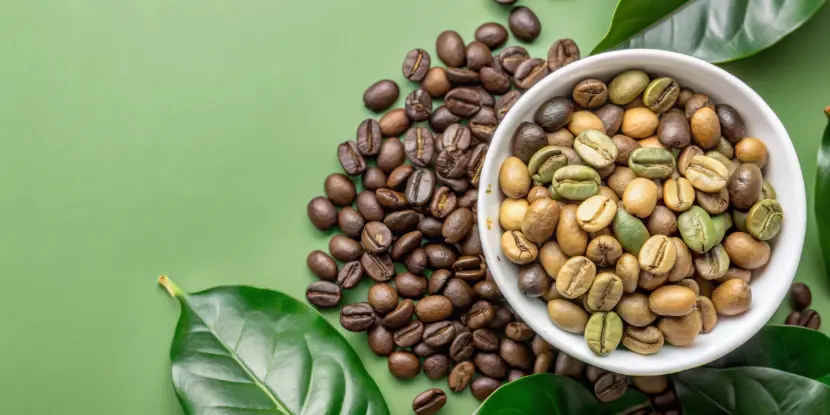
Coffee beans in various stages of roasting.
Where to Buy Coffee Beans for Cultivation
You can purchase coffee plant seeds or live seedlings online or at specialty garden stores. Some reliable sources include:
- Specialty coffee plant nurseries focus on coffee plants specifically.
- Look for well-reviewed sellers on platforms like Etsy or Amazon.
- Occasionally, local conservatories or botanical gardens sell coffee plant cuttings.
Optimal Growing Conditions
Light
- Coffee plants thrive in bright, indirect light.
- They prefer around 4–6 hours of filtered sunlight per day.
- Direct sunlight can scorch their leaves, so east- or west-facing windows are ideal.
- Grow lights can supplement natural light if needed.
Soil
- Use well-draining, slightly acidic soil with a pH of 6 to 6.5.
- A potting mix with 2 parts peat moss, 1 part perlite, and 1 part compost works well.
Temperature
- Coffee grows best in warm, consistent temperatures between 65°F and 75°F (18°C to 24°C).
- Avoid placing it near drafts, heaters, or air conditioners, which can stress the plant.
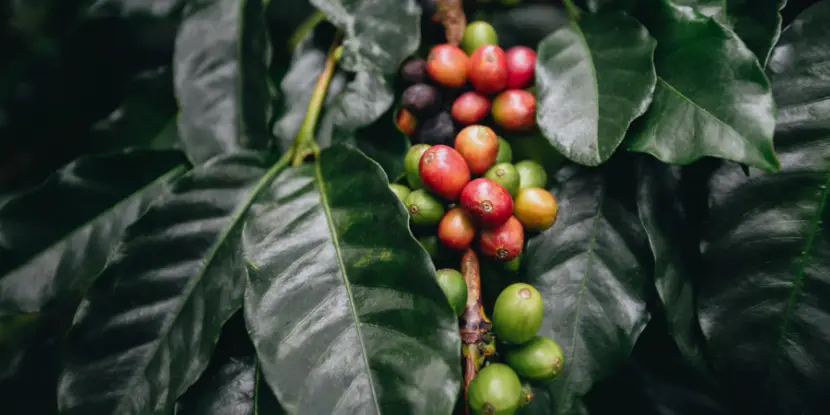
Coffee cherries as they begin to ripen.
Planting Coffee in a Container: Seedlings & Cherries
Choose a Suitable Container
- Select a container with drainage holes to prevent waterlogging.
- A 12 to 18-inch diameter pot allows room for growth.
Prepare the Soil
- Fill the pot with the well-draining soil mix described earlier.
- Leave space at the top to accommodate the plant and future watering.
Planting Seedlings
- Gently loosen the roots of the coffee seedling if root-bound.
- Place the seedling in the center of the pot, ensuring the root ball is slightly below the soil surface.
- Backfill with soil and press lightly to secure the plant.
- Water thoroughly after planting. Soil should be moist but not soggy.
- Place the container in an area with bright, indirect sunlight or under grow lights.
- Transplant the coffee plant into a larger container as it grows to prevent root crowding.
Planting from Coffee Cherries
- If starting from cherries, remove and clean the beans to expose the seeds.
- Plant the seeds about 1/2 inch deep in the prepared soil.
- Space multiple seeds at least 6 inches apart if using a larger container.
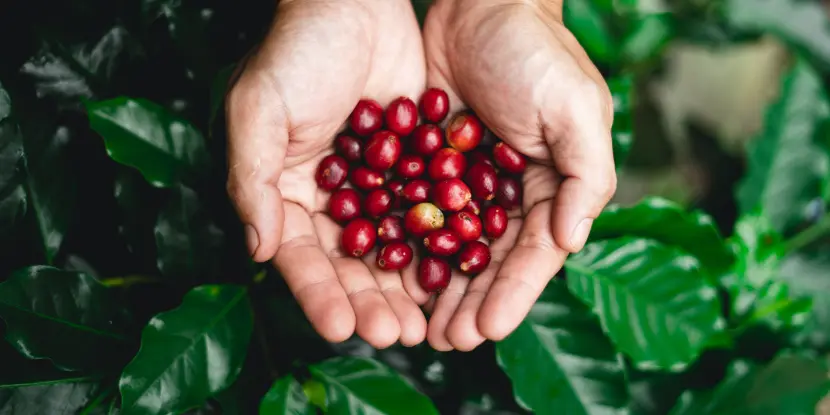
Ripe coffee fruit: good for the goats and almost ready for the roaster.
Coffee Plant Care
Watering
- Coffee plants prefer consistently moist soil. Avoid overwatering. Check the top inch of soil and water only when it feels dry.
- Use room-temperature water to prevent shocking the roots.
Fertilizer
- Feed your plant with a balanced fertilizer for acid-loving plants during the growing seasons—spring and summer. Apply every 4–6 weeks.
- Avoid over-fertilization, which can lead to salt buildup in the soil.
Pests & Diseases
- Coffee plants are susceptible to pests like spider mites, aphids, and mealybugs. Treat infestations with insecticidal soap or neem oil.
- Watch for root rot caused by overwatering. If the leaves turn yellow and fall off, reduce your watering frequency immediately.
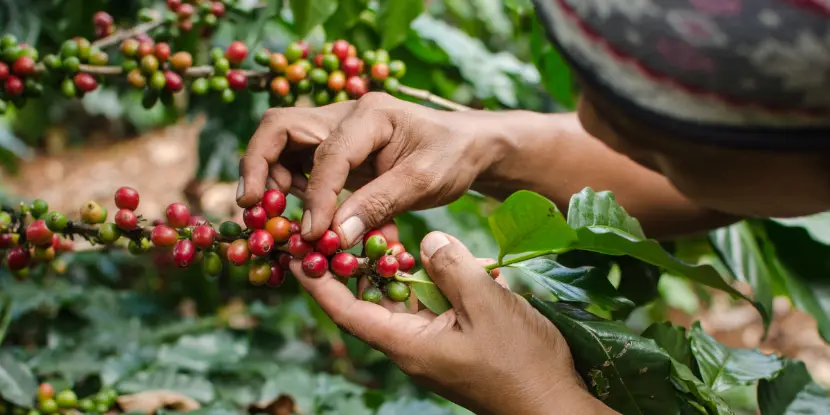
A worker hand-picks coffee cherries for the best possible flavor.
Harvesting Your Coffee Beans
- A coffee sapling typically begins to bear fruit after 3–4 years, depending on the variety and growing conditions.
- The most productive time for coffee plants is 7–20 years old.
- If well cared for, coffee plants can remain productive for decades.
- In general, you should wait until the coffee cherries turn red before harvesting. Ripe cherries will be bright red and slightly soft to the touch.
- Some coffee varieties are ready for harvesting when they’re yellow or orange. Research your coffee variety to determine the optimal harvest time.
- After harvesting, sort the cherries to separate the ripe ones from underripe or overripe fruits. This step ensures better quality during the processing phase.
A worker hand-picks coffee cherries for the best possible flavor.
Harvesting Methods
- For the highest quality, pick the ripe cherries by hand, selecting only the red ones.
- Strip harvesting — removing all cherries from the branch — is helpful for larger-scale cultivation.
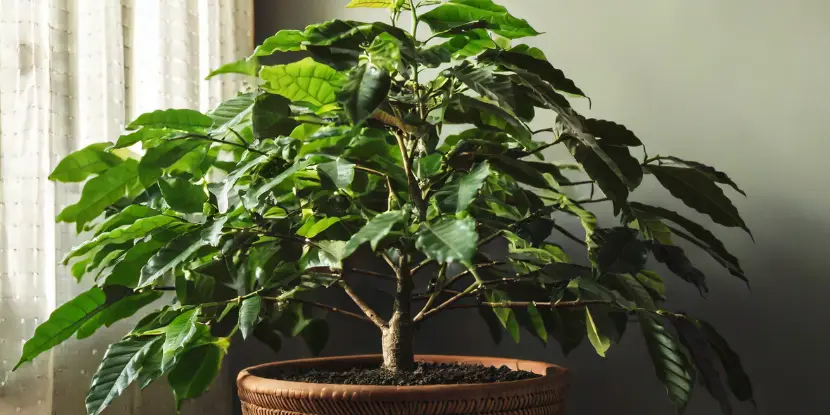
An indoor coffee plant thrives in filtered sunlight.
Outdoor Cultivation in California
Surprisingly, certain regions in California’s mild Mediterranean climate can support outdoor coffee cultivation. Coastal zones with stable temperatures and humidity are ideal. If growing coffee outdoors in California:
- Provide partial shade to protect plants from intense midday sun.
- Ensure they grow in rich, acidic soil and have a reliable water source.
Methods of Roasting Coffee Beans
Platforms like YouTube offer a wealth of instructional videos covering various techniques, step-by-step guides, and troubleshooting tips for beginners and seasoned roasters.
Coffee-focused forums and websites also provide detailed articles and expert advice for perfecting your roast.
- Using a Dedicated Home Roaster: A home coffee roaster is designed for precision and ease of use. These devices have adjustable settings to control roasting time and temperature for consistent results.
- Pan Roasting: This low-cost option entails using a stovetop pan to roast small batches of beans. It requires constant attention and stirring for even roasting.
- Oven Roasting: Beans can also be roasted in a conventional oven, though achieving uniform results may be challenging, and the process may generate smoke.
- Air Popcorn Popper: Some coffee enthusiasts use an air popcorn popper for roasting, as it provides the high heat and airflow needed for even roasting. However, it’s important to ensure your popcorn popper is suitable for coffee roasting.

The perfect cup of joe is your ultimate goal.
FAQs: Growing Coffee Indoors
Q: How long does it take to grow coffee beans at home?
It takes about 3–4 years for coffee plants to mature and produce their first cherries.
Q: Can I grow coffee from a roasted bean?
You can try, but this would be like growing broccoli from stir-fries. You’ll need raw, green coffee beans or seedlings.
Q: Do coffee plants grow better indoors than outdoors?
Coffee plants can thrive indoors with the right conditions, but outdoors is more suitable in tropical climates.
Q: How often should I repot my coffee plant?
Repot every 2–3 years or when roots outgrow the container.
Q: How tall will my indoor coffee plant grow?
Indoor coffee plants typically grow 4–6 feet tall, depending on the variety and care.
Q: Will my coffee plant actually produce beans?
Yes, with proper care, your plant can produce coffee cherries in a few years.
Q: Can I prune my coffee plant to control its size?
Yes. Trim overgrown branches to keep the plant compact and healthy.
Q: Are coffee plants safe for pets?
No, coffee plants are toxic to pets if ingested. Keep them out of reach from curious paws!

